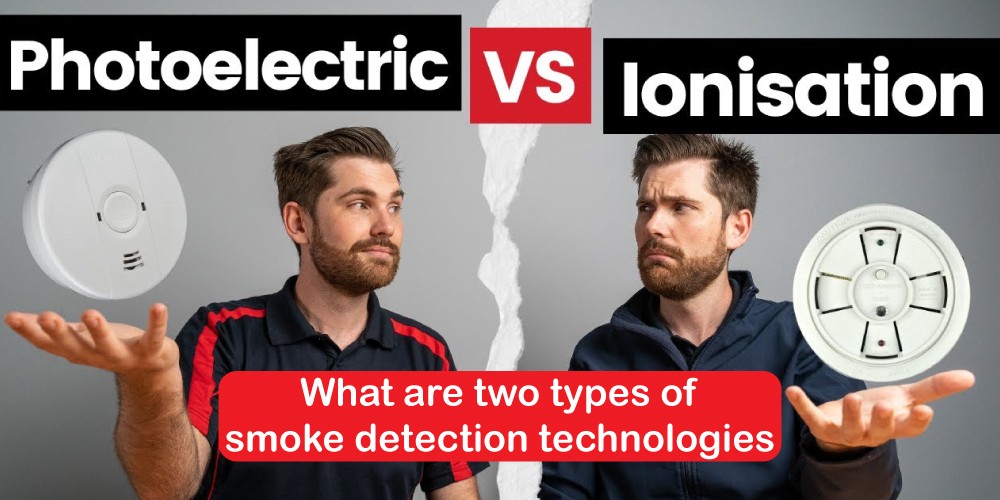Recognizing the Two Primary Categories of Smoke Detection Systems
Any fire safety plan must include smoke detectors because they provide early alerts that can reduce damage and save lives. Although they can take many different shapes, smoke detectors generally use two leading technologies: photoelectric and ionization. Every variety has advantages over the others and is made to identify specific types of fires. Comprehending these technologies is essential to select the best smoke detector for your requirements.
A smart smoke detector: what is it?
Smoke detectors are always working devices that, should they detect smoke, will transmit an alert signal to panels. A smart smoke detector is a gadget that looks for smoke and other combustion products using sensors. These gadgets can be utilized in home and business settings and are intended to warn early about a fire. Ionization sensing, photoelectric sensing, or both are commonly employed in smart smoke detectors. Wireless connectivity and audio alerts are additional features included in specific versions.
How Do Intelligent Smoke Detectors Operate?
A smart smoke detector is a gadget that uses sensors to look for smoke or fire in a house or other structure. Due to their network connectivity, these gadgets can communicate with one another and notify other smart device users or homeowners in the event of a fire. In addition to these functions, intelligent smoke detectors may monitor temperature and detect carbon monoxide.
The Importance of Smoke Alarms
Understanding why smoke alarms are a crucial component of any building’s safety infrastructure is essential before diving into the many types of smoke alarms. When smoke particles are detected in the air, smoke alarms are the first defense against fires. These gadgets sound a loud, piercing alarm when they detect smoke, warning inhabitants of the possible danger and giving them crucial seconds to respond and flee.
Which Kinds of Smart Smoke Detectors Are There?
Smart smoke detectors fill today’s market with a wide variety. Among the most well-liked choices are:
Smart thermostats: These gadgets can activate the air conditioner or fan in response to smoke detection, clearing the air and halting the spread of fire.
Smart sprinklers: When a fire breaks out, the gadgets connected to your building’s water supply will immediately turn on and start sprinkling water on the flames.
Smart alarms: These gadgets can link to your building’s security system. If they detect smoke, they will sound an alarm, warning people to leave immediately.
Installing smart cameras throughout your house or place of business will allow you to keep the necessary documentation during a fire. These devices will start to record as soon as they detect smoke.
Two types of smoke detection technologies

It is impossible to overestimate the significance of early smoke detection. Fires can spread quickly, spewing poisonous smoke and lethal fumes across the room. Smoke alarms can prevent property damage and save lives by promptly enabling the evacuation of people when a fire is just beginning.
Detectors of Ionisation Smoke
Ionisation smoke detectors effectively identify fast-flaming fires or those that spread rapidly yet produce minimal visible smoke. A tiny quantity of radioactive material, usually americium-241, is present inside the detector and ionizes the air, causing an electrical current to flow between two charged plates. Smoke impedes ionization by attaching itself to the ions and decreasing the current flow as it enters the chamber. This decrease in current sets off the alarm.
Ionisation Smoke Alarm Benefits:
- Rapid Reaction to Quick-Burning Flames: Ionisation smoke alarms react quickly to blazing, fast-burning flames, including those started by paper or wood.
- Cost-effectiveness: They are generally less expensive than photoelectric smoke alarms, which makes them a better option.
- Ionization smoke alarms’ limitations: Minimal Sensitivity to Smouldering Fires: Ionisation alarms are not as sensitive to slow-moving fires that emit dense smoke before the appearance of flames.
- False Alarms: Cooking smoke or steam is more likely to cause false alarms in them.
Ideal For:
- Spotting quickly spreading fires, such as ones started by paper or combustible substances.
- Locations with a higher chance of fires spreading swiftly without first producing a lot of smoke.
Taking into account
- Smoldering fires can produce more smoke before igniting. Therefore, ionization detectors might be less sensitive.
- If kitchens are too close, false alarms are more likely to be triggered by steam or smoke, causing them to be activated.
2 Detectors of Smoke using Photoelectric
How They Operate: Since smoldering fires frequently emit a lot of smoke before igniting, photoelectric smoke detectors are more effective at spotting them. These detectors use an LED or other light source pointed at a sensor housed in a different chamber. The laser beam does not reach the sensor in normal circumstances. But as the smoke enters the chamber, it scatters the light, making part of it strike the sensor. This sets off the alarm.
Ideal For:
- Spotting slow-burning flames, including those originating from beds, electrical wiring, or charred upholstery.
- Areas like living rooms or bedrooms where slow-burning fires are more likely to happen.
Taking into account
- Photoelectric detectors can be placed close to kitchens and toilets since they are less prone to cause false alerts from steam or cooking odors.
- When a fire flares up, it cannot react as quickly as ionization detectors.
Which One Should You Select?

While photoelectric and ionization smoke detectors work well, they best identify specific kinds of fires. The National Fire Protection Association (NFPA) advises installing both detectors or choosing a dual-sensor smoke alarm. that integrates photoelectric and ionization technology to guarantee complete coverage. With this strategy, you and your loved ones can feel secure knowing that it offers the finest defense against both quickly spreading flames and simmering fires, and protects you from various fire threats.
Pros and Cons of Smart Smoke Detectors:
Installing an intelligent smoke detector in your place of business has a lot of advantages. You can integrate these devices with other smart devices in your home or place of business. You can operate them remotely and receive alerts on your phone. Managing an intelligent smoke detector from a distance is one of its main advantages. This implies that you may quickly turn it on from your phone. If you fail to do so before leaving for work. If the smoke detector goes off. You can also get alerts on your phone, which is helpful if you’re not at home or work.
In summary
Making an informed decision on fire safety requires knowing the distinctions between photoelectric and ionization smoke detectors. Choosing the appropriate smoke-detecting technology—or a mix of both. Can make all the difference in terms of early warning and life safety. Whether you’re protecting your house, workplace, or another area.

